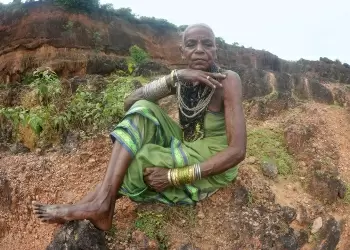A tribal tradition faces extinction as urban culture seeps into the forests
08-November-2014
Vol 5 | Issue 45
Having survived over the centuries carrying the hoary tradition of their ancestors, the aboriginal older generation, especially its womenfolk, is at their wits' end on how to perpetuate their rich legacy.
"From being the last generation, we are wary of becoming a lost generation, as our progeny is not interested in following values, customs and traditions or living our way of life. They are after modern life at the cost of our moorings," said the unique tribal community's head, Chaudappa, 60.
 |
|
A Halakki tribal woman in traditional attire and heavy jewellery (Photo: IANS)
|
Spread across scores of hamlets in Uttara Kannada district, about 470 km from Bangalore, the Halakki tribe is grappling with the challenge of preserving its rich culture, rituals, artifacts and rustic life in the face of resistance from generation next.
Literacy and exposure to urban lifestyle in nearby towns alienated the tribal kin to abandon their colourful attire comprising distinct jewellery, colourful beads and bangles, long necklaces, heavy ear and nose rings and wearing a sari without a blouse.
"Our daughters and grand-daughters don't like to wear our unique dress. They prefer salwar-kameez, leggings and tops. The sons are worse, as they are fond of wearing jeans and T-shirts rather than our tribal dress," lamented 75-year-old Sukri Bommagowda, a grand old lady of the tribe.
The ravages of time and modernisation have dramatically changed even the tribe's age-old wedding customs. Gone are the good old days when a boy came of age, his parents would select a girl and pitch a tent in front of her hut till she agreed to marry him.
"Believe it or not, matrimony ads are posted online (Bandhan.com) under 'Brides and Grooms for Halakki Vokkaligaru'. Instead of elders or parents, boys and girls choose partners and decide when to tie the nuptial knot. In our days, we could not dare to meet our prospective bride before the wedding, as it was the prerogative of our elders to decide whom to marry and when," Choudappa recalled.
Though marriages are held still within the community, they are not as elaborate and ritualistic as they were till a generation ago. Like festivals, a wedding in a Halakki family was a grand occasion for all the folks in the hamlet to gather and celebrate with a common drinking and feasting session. It is no longer so for socio-economic reasons, with many families splitting and migrating to other hamlets in the region.
According to the 2011 census, the majority of the Halakki tribals, numbering over 200,000 dwell in a cluster of villages dotting the coastline from Sirsi to Karwar near Goa. When their population multiplied in the past, many families migrated to Dakshina Kannada and Shivamogga district in the Malnad region for more land, space and better life.
"Halakki tribe is different from other tribes like Siddhis or Soligas. Their ancestors were from Rayalaseema forests in Andhra Pradesh and migrated to north and coastal Karnataka over the centuries but retained their identity, customs and way of life," says folklorist and documentary film maker Sirigandha Sreenivasa Murthy.
Interestingly, gender ratio (2:1) has been in favour of females unlike in other communities or parts of the country, as women are worshipped and considered a descendant of the tribe's Tulasi Katti mythological goddess or deity.
"They still live in mud houses with dry leaves of coconut or palm trees as sloping roofs and small windows on three sides for ventilation and breeze. Every hut has a Tulasi (herbal plant) in the front. Water is drawn from wells or streams," Murthy said.
Growing paddy and seasonal crops continues to be the tribe's main livelihood while fishing in ponds, lakes and rivers flowing into the Arabian Sea and collecting minor forest produce such as firewood, dry leaves for rolling beedis and herbs for natural remedies are seasonal occupation.
"Besides taking care of domestic chores like cooking, washing and tending children, women help their men in farming, fish collection and rearing cattle. But their children don't to want to continue with their parents' occupation or old-fashioned living.
“Fruits of education and skill training through state welfare schemes and funds have made tribal youth aspire for better life and migrated to towns and cities in pursuit of jobs, leaving behind their parents and elders," Murthy noted.
Captivated by the grace, beauty and old world charm of the womenfolk, city-based ace lensman K. Venkatesh ventured into their secluded koppas (settlements) to capture them in their grandeur, wearing traditional attire with beads and chains for posterity.
"I was fascinated by the older womenfolk being so proud of their unique dress, jewellery, including beads, necklaces, nose rings and a dozen bangles on their hands, which they wear all the time as a prized possession," Venkatesh said at a photo expo he held at the Karnataka Chitrakala Parishat here last week to felicitate and honour some of the Halakki women. - IANS














